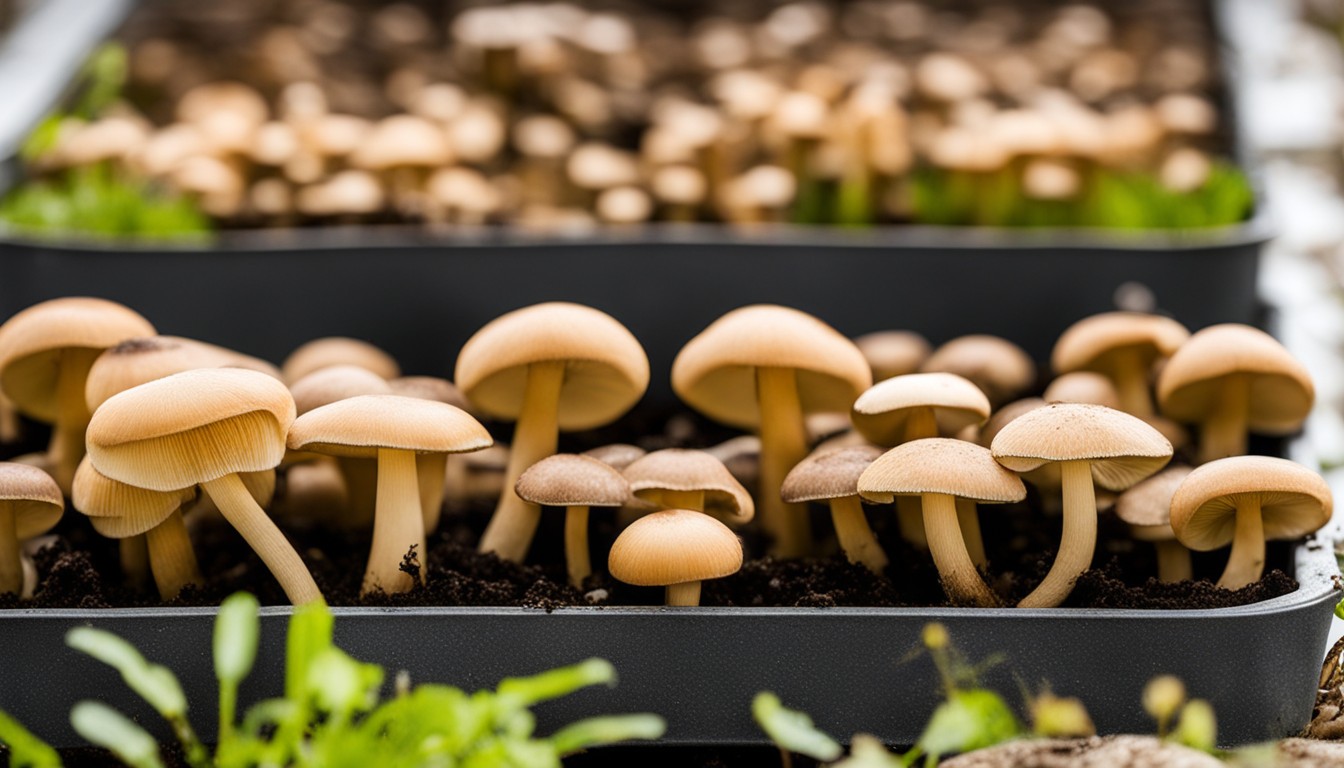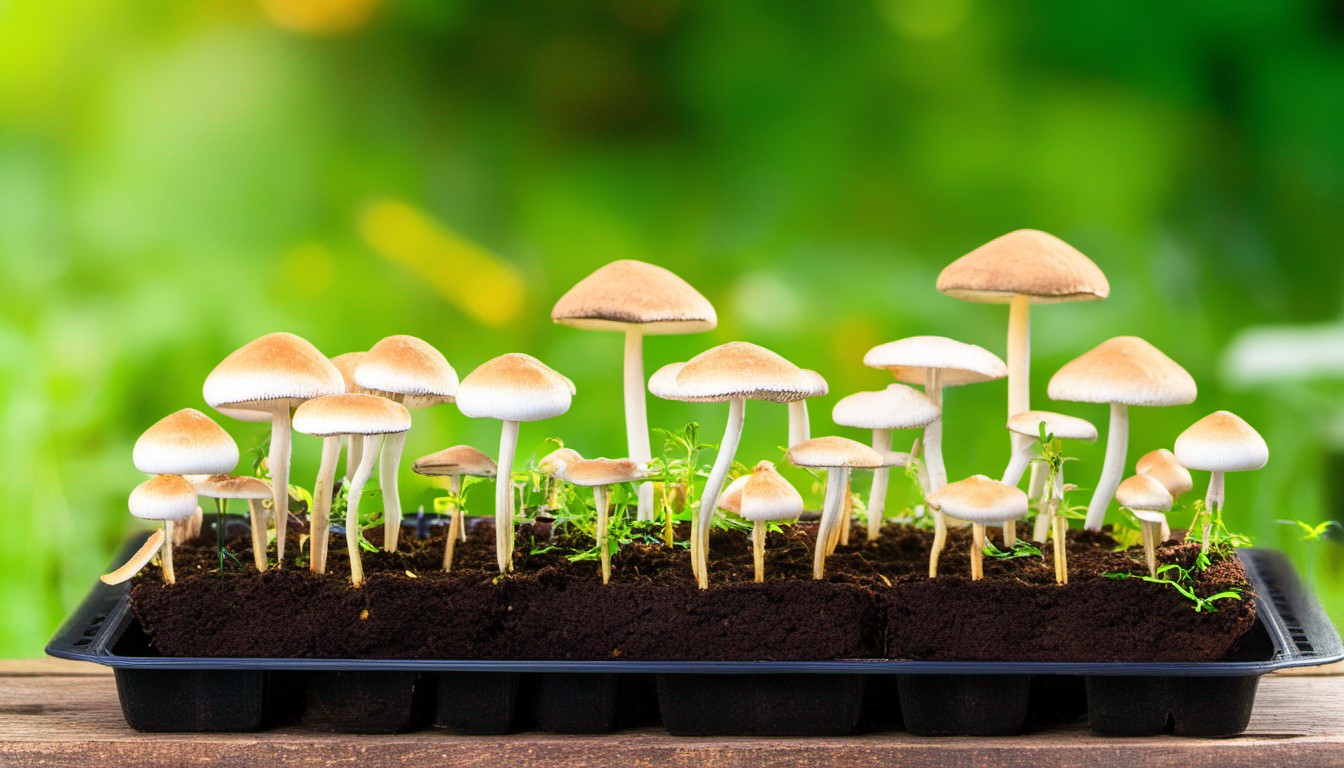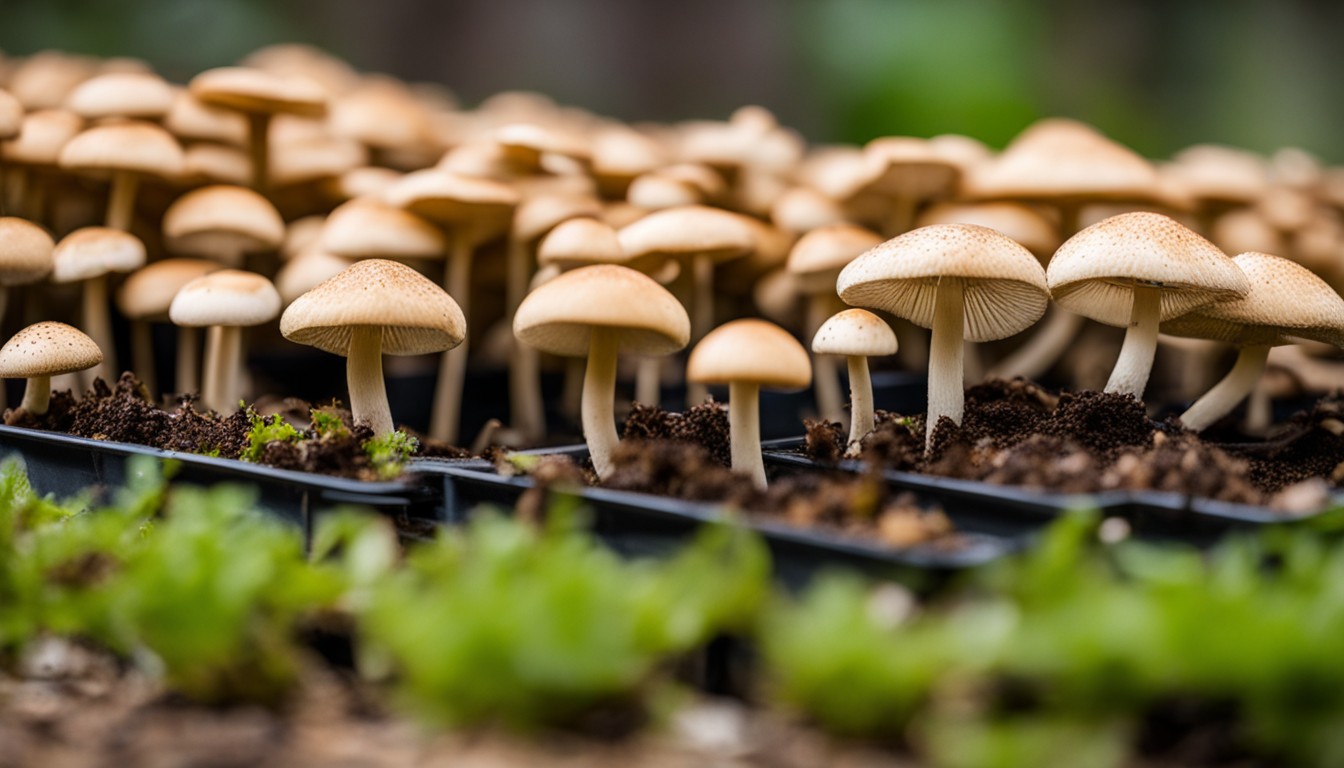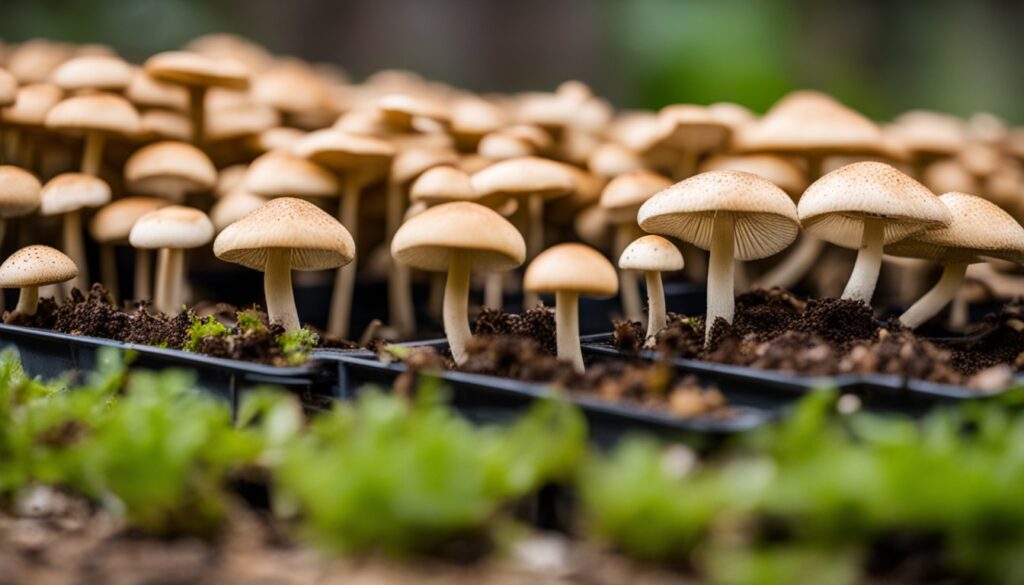Growing mushrooms in seed trays is a fascinating endeavor that allows you to cultivate these delicious fungi in a controlled environment. Whether you’re a seasoned gardener or a novice enthusiast, this blog post will provide you with tips and techniques to successfully grow mushrooms in seed trays. From choosing the right mushroom species to preparing the substrate and providing optimal growing conditions, you’ll gain valuable insights into the entire cultivation process. So, grab your seed trays and let’s embark on a mushroom-growing adventure together!
Choosing the Right Seed Tray
A proper understanding of tray sizes and materials is paramount for effective mushroom cultivation. The suitability of the tray depends on the mushroom type and the available space for cultivation.
For successful mushroom growth, choose a durable, resistant tray with appropriate drainage. A large dimension tray is ideal for commercial growth while smaller trays are preferable for personal growth.
Understanding Tray Sizes and Materials
Mushroom growth can be directly influenced by the choice of tray sizes and materials. Understanding the impact of each type can ensure a successful yield.
- Small and shallow trays: Ideal for small varieties of mushrooms, but may require frequent watering due to limited soil capacity.
- Large and deep trays: Suitable for larger mushroom varieties and offer more water retention, reducing the need for constant watering.
- Plastic trays: Most common and budget-friendly material. They’re durable, reusable and easy to sterilize.
- Clay or ceramic trays: Natural material that allows great aeration, but they’re heavier and more prone to breaking if not handled carefully.
- Fiberglass trays: Lightweight and long-lasting but may be more expensive. They provide excellent moisture retention.
- Biodegradable trays: Eco-friendly option that can decompose naturally. However, they may not be as durable or reusable as other materials.
Ensuring Proper Drainage
Proper drainage is critical for successful mushroom cultivation in seed trays, as it prevents over-saturation and root rot while maintaining the ideal moisture levels necessary for growth.
- Adding a layer of small gravel or pebbles at the bottom of the tray before adding the growing medium.
- Ensuring trays have enough holes or a grid base for water outflow.
- Regulating watering frequency to avoid soil becoming overly saturated.
- Using a tray with slightly slanted sides can aid water flow.
- Elevating the tray off the surface to facilitate water escape.
Optimal Tray Depth and Dimensions
The depth and dimensions of your seed tray significantly influence the growth and yield of your mushrooms. Choosing the correct depth and size for each specific mushroom variety allows for optimal development.
- Evaluate the mature size of your mushroom variety to determine tray depth.
- For larger mushroom varieties, deeper trays (2-3 inches) are recommended.
- Smaller mushroom types generally thrive in shallower trays.
- Ensure tray dimensions provide ample horizontal space for spreading mycelium.
Selecting the Right Mushroom Variety
The process of mushroom cultivation in seed trays begins with choosing the appropriate variety. Factors such as light, temperature, humidity requirements, and the nature of the growing substrate should inform your decision.
Optimal mushroom cultivation relies on strategic variety choice, considering growth rate, environmental preferences, and maturity duration for successful seed tray growth.
Different mushroom varieties resonate differently with seed tray cultivation. Analyze factors like growth rate, preferred environment conditions, and maturity span to determine the best types for effective seed tray growth.
Popular Mushroom Varieties for Seed Trays
In growing mushrooms using seed trays, it’s essential to carefully consider the variety you’ll cultivate. Different strains such as Shiitake, Portobello, Oyster, and White Button Mushrooms each have unique growth capabilities and suitability for tray growth.
- Shiitake mushrooms thrive well in seed trays, offering a distinct, earthy flavor appreciated by many.
- Portobello mushrooms, known for their large, hearty caps, can also be grown in trays to ensure a consistent supply.
- Oyster mushrooms are excellent candidates for tray cultivation, owing to their resilience and adaptability.
- White Button Mushrooms, a classic choice, proves tops for growth in trays, providing a reliable yield in most conditions.
Considerations for Indoor and Outdoor Growing
Indoor and outdoor mushroom cultivation pose distinct sets of considerations regarding environmental factors and growing conditions. Knowledge of these factors can help optimize mushroom yield.
- For indoor cultivation: control over humidity, temperature, light exposure, and potential contamination sources.
- For outdoor growing: assessment of site suitability, seasonal climate effects, pest management, and natural elements like rainfall and sunlight.
Matching Mushroom Varieties to Tray Sizes
Mushroom species vary in their space requirements, and understanding this is pivotal to successful cultivation. For example, button mushrooms require less space compared to larger varieties such as king oyster mushrooms.
Seed trays should be selected based on the growth patterns of your chosen mushroom variety. Creeping varieties may need more horizontal space, while upright varieties may benefit from deeper trays.
Inadequate tray dimensions can stress your mushrooms, affecting their growth and yield. While undercrowded trays waste growing space, overcrowded ones may stunt mushroom development due to lack of necessary nutrients.
Flexibility is key when balancing tray sizes with mushroom growth patterns. Larger trays may be divided into compartments to allow for diverse cultivation, while smaller trays can be stacked or arranged to maximize space usage.
Preparing the Seed Tray for Mushroom Growth

Equip your seed tray for optimal mushroom cultivation by sterilizing the tray, moistening the growing medium to the right consistency, and inoculating with mushroom spawn. These preparatory steps ward off adversaries like bacteria and mold.
To actualize a thriving growth atmosphere within your seed tray, attention must be given to maintaining the optimal temperature and humidity. This aims to recreate the mushroom’s natural habitat, bolstering its prospects for successful growth and healthy output.
Sterilizing the Seed Tray and Growing Medium
Before introducing mushroom spawn into your seed trays, total sterilization is essential. Cleaning both your trays and growing medium eliminates contaminants that could hinder the growth of your mushrooms, providing a safe start for your cultivation efforts.
The growing medium should also undergo the sterilization process. This method guarantees the purity of your medium, reducing the risk of disease or competition and buoying your mushrooms’ chances of fruitful cultivation.
Moistening the Growing Medium to the Correct Consistency
Perfecting the moisture levels in your growing medium is an art required for successful mushroom cultivation in seed trays. It involves striking the ideal balance, neither too dry nor too saturated. This ensures the mushroom spawn remains healthy and thrives.
Regulating moisture is pivotal because mushrooms comprise mostly water. Having a well-moistened medium supports vigorous growth, encouraging the mycelium to colonize the entire tray effectively and enhancing overall yield.
Understand that over-moistening can cause issues, including mold growth and drowning the mycelium. Alternatively, if the medium becomes too dry, it can hamper the mycelium’s development, discouraging mushroom formation.
To ascertain the correct consistency, aim for a damp, wrung-out sponge feel. The growing medium should hold together when squeezed, but it should not drip water excessively. Regular checks will help maintain ideal moisture levels, aiding in successful mushroom cultivation.
Inoculating the Seed Tray with Mushroom Spawn
Inoculating your seed tray with mushroom spawn is a decisive moment in mushroom cultivation. Mastering this technique maximizes the potential of your seed trays. Be diligent and deliberate, ensuring every section of the growing medium has contact with the spawn to boost colonization.
Inadequate inoculation can hamper your mushroom growth. To avoid this, consider the amount of spawn required. The rule of thumb is a spawn to substrate ratio of 1:10. For example, if your tray holds 10 kg of substrate, you’ll need 1 kg of spawn.
Akin to planting seeds in a garden, the depth of inoculation is vital. Scatter your spawn evenly on top of the substrate, then gently mix it into the top layer. This helps the spawn integrate with the growing medium to accelerate the growth process.
Equally important during inoculation is maintaining sterile conditions to minimize contamination risk. The spawn itself should be fresh, pure, and uncontaminated. Undertake the process in a controlled environment, free from airborne contaminants, for the best chance of success.
Remember, the goal of inoculation is to foster rapid and robust mushroom growth. Temperature control is a key factor post-inoculation. Warmth speeds up mycelium growth, but excessive heat can be detrimental. A constant temperature of around 70-75°F works best for most species.
Providing Optimal Temperature and Humidity
Mushroom growth positively thrives when the optimal temperature and humidity conditions in seed trays are achieved. The delicate balance of warmth and moisture proves critical in fostering healthy, robust mushroom development.
Shifting temperatures can induce stress in mushrooms, potentially hindering growth. For most varieties, a steady temperature between 55 to 75 degrees Fahrenheit forms the ideal climate.
Humidity plays an equally fundamental role in mushroom cultivation. Mushrooms have high water content; hence an environment mirroring this aspect supports their growth. Aim for a humidity level ranging from 80% to 95%.
Strategic planning aids in maintaining these conditions. Some effective tactics include using room heaters or coolers to control the temperature, and humidifiers or misting to manage humidity.
Cultivating mushrooms in a controlled environment like seed trays allows for precision in maintaining desired temperature and humidity. The careful regulation of these factors often yields a plentiful, quality crop, revealing the critical importance they hold.
Caring for Mushroom Seed Trays

Diligence in the ongoing care and maintenance of your mushroom seed trays is vital for optimal mushroom growth. From appropriate watering measures to promptly managing any sign of disease, each step is crucial in preserving the health of your growing fungal garden.
An integral part of successful mushroom cultivation is the preservation and well-monitored handling of your seed trays. Proper light management, timely harvest, and quick resolution of any issues can significantly improve the quality and yield of your home-grown mushrooms.
Watering the Seed Tray Properly
Regular and balanced watering is vital to mushroom growth in seed trays. Avoid drenching the substrate, aim for a slightly damp consistency. Your watering method may involve misting, soaker hoses, or wick watering systems.
Understanding the right amount of water is crucial in tray cultivation. Mushrooms demand a high moisture level, but overwatering can discourage growth and prompt mold. Aim for a humid environment, not a waterlogged one.
Altering watering habits according to the mushroom’s growth stage is essential. In the initial colonization phase, keep the substrate moist, then reduce watering as fruiting bodies emerge to prevent rot and ensure a bountiful harvest.
Remember, each mushroom species may present unique watering needs. Understanding these requirements can help maintain the correct balance between overhydration and underwatering, optimizing your cultivation efforts and ensuring healthy, prolific mushroom production.
Monitoring for Signs of Contamination or Disease
While cultivating mushrooms in seed trays, keeping a vigilant eye on your crop is essential. Prompt identification of issues allows for immediate action. Common signs of contamination include odd colors, strange smells, and unusual mushroom growth patterns.
To manage contamination in seed tray cultivation, it’s advisable to promptly remove and dispose of affected mushrooms. This prevents the possible spread of any pathogens and thus safeguards the remaining healthy fungi.
In seed tray mushroom cultivations, contaminants aren’t the only concern. Diseases can also threaten your crop. Yellowing, wilting or slow growth often indicate disease invasion.
Should you detect disease in your seed tray, isolate the affected tray immediately. Next, apply organic fungicides, or if the infection is severe, chemical ones. Remember, prevention is better than cure, so maintain a clean, balanced growing environment.
Proper hygiene practices are indispensable in disease prevention for seed tray cultivation. Regularly clean and sterilize cultivation equipment, ensuring optimal conditions for mushroom growth and reducing risks of contamination and disease.
Managing Light Exposure for Maximum Growth
While a common myth suggests mushrooms thrive in total darkness, truth reveals they benefit from a controlled light exposure. Certain wavelengths, particularly in the blue spectrum, stimulate mycelium growth. Thus, understanding a given mushroom strain’s light preferences is instrumental to successful seed tray cultivation.
Rather than bet on natural light, consider manipulating conditions using indoor grow lights. Opt for a cool, blue spectrum bulb that can accommodate different stages of growth without overheating the colonization environment. The advantage of indoor lights is the ability to adjust exposure duration in response to your colony’s unique demands.
Light management extends beyond periods of exposure. The direction of light significantly influences the shape of growing mushrooms. Positioning the light source above the seed tray facilitates upright growth, while side-lighting may result in slanting growth patterns. Employ this knowledge to produce a desired growth structure.
Harvesting Mushrooms at the Right Time
Knowing when to harvest mushrooms grown in seed trays hinges on the mushroom variety and their visual cues. Most often, mushrooms are ready to harvest when the cap is fully unfurled, but still slightly curled under at the edges.
Timely harvesting is vital for both yield and quality. Harvesting at the correct stage helps maximize the flavor of the mushrooms and prevents them from becoming overripe and tough. Additionally, timely harvest prevents the mushrooms from releasing spores, which can reduce further yield.
Monitoring your mushrooms’ growth can help determine optimal harvest time. If you notice irregularities such as darkened caps or shrivelled stems, these may be signs of over-maturity. Regular, precise observations ensure high quality homegrown mushrooms.
Troubleshooting Common Issues in Mushroom Seed Trays
Experience has shown that mushroom farming in a seed tray is not without its difficulties. From issues like mold infestation to watering inconsistencies, each challenge requires a unique solution tailored to its specifications.
Embracing the art of eliminating common problems in seed tray mushroom cultivation involves a keen eye for potential problems, understanding their causes, and applying strategic interventions in a timely manner, thereby ensuring a bountiful harvest.
Dealing with Mold or Fungus Problems
Mold and fungus can pose tremendous challenges for mushroom cultivators using seed trays. Regular inspection is key, ensuring any growths are discovered and addressed before irreversible damage is done to your cultivation. Thereafter, actions can be taken to prevent reoccurrence.
Identifying mold or fungus early requires a keen eye. Often, they begin as tiny white spots, or an unusual change in color of the mushroom cap or stem. Swiftness in identification is paramount to prevent spore proliferation.
Once identified, the afflicted sections should be removed immediately. If the issue is widespread, a complete overhaul might be necessary. To safely dispose of the infected material, seal it in a plastic bag, reducing chances of airborne spore dissemination.
Mold and fungus thrive in certain conditions. Maintaining proper ventilation, ensuring sufficient light exposure and controlling moisture levels can aid in preventing their growth. A well-managed environment empowers you to successfully defeat mold and fungus issues in your mushroom seed trays.
Addressing Watering or Moisture Issues
Overwatering in mushroom seed tray cultivation can aggravate the risk of mold and disease. Contrarily, under-watering may compromise mycelium development, leading to reduced mushroom yield. Both conditions may result in stunted mushroom growth or even seed tray ‘failure’.
To address this delicate balance, implementing moisture regulation strategies is essential. Too much water in the seed tray can suffocate the mushroom spawn. Conversely, not enough can leave it parched, inhibiting growth.
Utilizing a hygrometer can provide accurate humidity measurements, aiding in moisture maintenance. Aim for a humidity range of 80-95%, optimal for most mushroom strains growth. It’s about creating an environment that mimics the damp, dew-drenched woodland floors where mushrooms naturally thrive.
Ultimately, good water management comes down to vigilance and knowledge. Learn the needs of your specific mushroom variety, and be attentive to any signs of distress. Lifestyle changes, like yellowing or wilting, may indicate watering issues.
Managing Insect or Pest Infestations

Identifying pests early is crucial in mushroom cultivation. Familiarize yourself with common pests like fungus gnats, mites, and slugs. If prevention fails, consider organic insecticides or introducing natural predators.
Investing in pest prevention strategies is as essential as any aspect of mushroom cultivation. Physical barriers, insect-resistant strains, and regular tray inspections will significantly reduce pest risks. If infestation occurs, non-toxic control methods are advisable for a healthy harvest.
Frequently Asked Questions (FAQ)
Welcome to our Frequently Asked Questions (FAQ) section, where we answer common queries about growing mushrooms in seed trays.
What are the benefits of growing mushrooms in seed trays?
Growing mushrooms in seed trays offers several advantages, including a controlled growing environment that allows for optimal conditions, efficient use of space, and easier maintenance compared to other cultivation methods. With seed trays, you have the flexibility to grow a variety of mushroom species and experiment with different techniques.
Which mushroom species are suitable for growing in seed trays?
Many mushroom species can be successfully grown in seed trays. Some popular choices include oyster mushrooms (Pleurotus ostreatus), shiitake mushrooms (Lentinula edodes), white button mushrooms (Agaricus bisporus), and lion’s mane mushrooms (Hericium erinaceus). Each species has its own unique growth requirements and characteristics.
How do I choose the right seed trays for mushroom cultivation?
When selecting seed trays for growing mushrooms, it’s important to consider factors such as drainage, ventilation, and size. Opt for trays with good drainage holes to prevent waterlogging, ventilation holes to ensure proper airflow, and a suitable size to accommodate the mushroom species you intend to grow.
What substrate should I use in my mushroom seed trays?
The choice of substrate depends on the mushroom species you are cultivating. Common substrates include pasteurized straw, sawdust, wood chips, or a combination of these materials. Each mushroom species has specific substrate preferences, so it’s important to research and select the appropriate substrate for optimal growth.
How should I prepare the seed trays for mushroom cultivation?
Before filling the seed trays with substrate, it’s essential to sterilize them to prevent contamination. Sterilization can be done through heat treatment, chemical sterilization, or a combination of both methods. Properly prepared seed trays provide a clean and favorable environment for mushroom growth.
What are the ideal growing conditions for mushrooms in seed trays?
Mushrooms thrive in a moist and dark environment, typically with humidity levels ranging between 80% and 90%. The ideal temperature for most mushroom species in seed trays ranges from 60 to 75°F (15 to 24°C). Adequate air circulation is also crucial for their growth, so ensure proper ventilation in your growing area.
How long does it take for mushrooms to grow in seed trays?
The growing time varies depending on the mushroom species, substrate, and environmental conditions. On average, mushrooms can be harvested within 3 to 4 weeks after the substrate has been fully colonized by the mycelium. However, some species may take longer or shorter periods to mature.
How do I maintain and care for mushrooms in seed trays?
Regular misting to maintain moisture levels, monitoring and adjusting humidity, ensuring proper air circulation and ventilation, and monitoring for signs of pests or diseases are essential for the health and productivity of mushrooms in seed trays. Additionally, following proper watering and maintenance schedules specific to the mushroom species you are growing is crucial for successful cultivation.
Can I reuse the seed trays for subsequent mushroom cultivation?
Seed trays can be reused for multiple cultivation cycles, but it’s important to thoroughly clean and disinfect them between each cycle to avoid the risk of contamination. Cleaning procedures may involve washing with hot water and soap, using bleach or hydrogen peroxide solutions, or employing other sterilization methods.
What are some common challenges and troubleshooting tips for growing mushrooms in seed trays?
Common challenges in mushroom cultivation include contamination, inadequate moisture or drying out, improper temperature and humidity control, and pest infestations. To overcome these challenges, it’s essential to follow proper sterilization techniques, maintain optimal growing conditions, and promptly address any issues that arise. Regular monitoring and adjusting of environmental factors are vital to successful mushroom cultivation.
Where can I find mushroom spawn or spores to start my cultivation in seed trays?
Mushroom spawn or spores can be obtained from specialized mushroom suppliers, reputable garden centers, or online retailers. It’s important to source them from reliable sources to ensure quality and success in your cultivation efforts. Consider choosing a supplier that provides detailed instructions and support for beginners.
Conclusion
The complexities of mushroom cultivation in seed trays involve selecting the right tray, a suitable variety, preparing your trays, and diligent care of your mushroom seedlings. Ensuring all these procedures are met guarantees a bountiful mushroom harvest.
Unlocking success in cultivating mushrooms in seed trays is a process that requires expertise and patience. However, by following the right advice and troubleshooting any problems early, you can reap rewards in the shape of healthy, home-grown mushrooms.
- Choose the correct tray size and material for the variety of mushroom you wish to grow.
- Ensure the seed tray has adequate drainage and the correct depth and dimensions.
- Understand the characteristics of popular mushroom varieties, and match them to your seed tray and growing conditions.
- Properly sterilize your seed tray and growing medium, and inoculate the seed tray with mushroom spawn.
- Maintain optimal temperature and humidity for your mushroom variety.
- Monitor watering, light exposure, and signs of contamination or disease, and harvest mushrooms at the right time.
- Troubleshoot common issues such as mold, moisture, or pest infestations swiftly.

